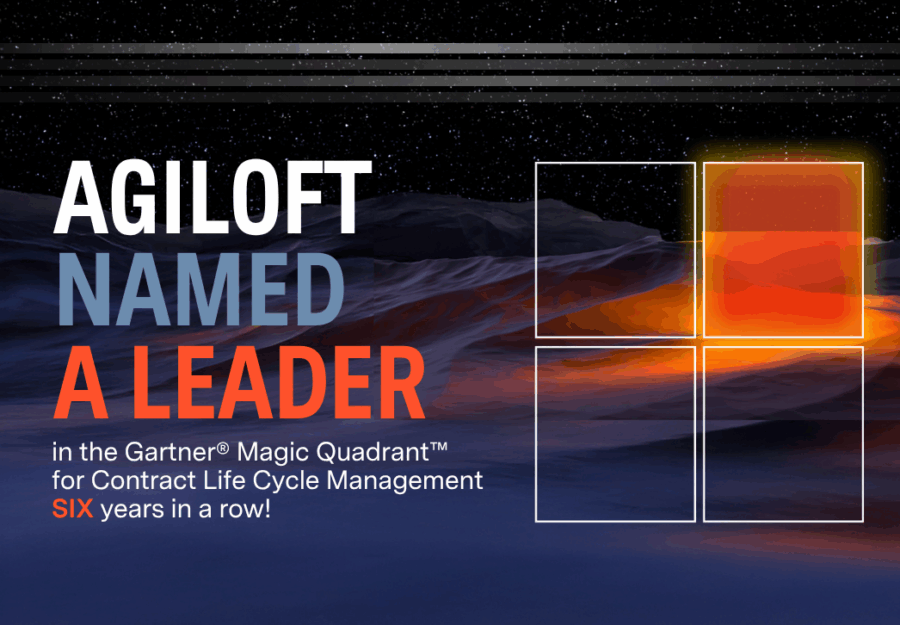
How to get the most out of your CLM? Level up your maturity across the enterprise
Learn how you can build a growth strategy, optimize your contract process, and benefit from increased revenue and savings.

In today’s world, it seems like a new piece of technology hits the market every day. While technology, more specifically software, is designed to solve a problem, it’s not often that any one solution is going to solve all your problems.
Inevitably though, a new friction point will arise, and a new problem will need to be solved. For example, while you might have initially invested in a Contract Lifecycle Management (CLM) system to digitize your contracts, you’re now experiencing a problem with digital signature collection and want to implement a self-service contract workflow. Our initial instinct? We might wonder what’s the latest and greatest technology on the market that we can buy to solve our new problem. It’s so tempting – there’s something new and flashy every day!
But before you start searching, have you tried taking a look under the hood?
While it’s true that there’s not one single software application to rule them all, studies say that average operators are only using about 20-30% of their existing software capabilities. While we’ve all heard the phrase, “do more with less,” if you’re properly managing your technology stack for the future, we need to make the transition to “do less with less.”
The hidden costs of constantly chasing new tech
While buying a new technology might be an initial instinct, it’s important to remember all that truly goes into investing in a net new software system. The investment alone stretches beyond licensing or packaging costs. Teams often budget for hard costs like initial implementation, architectural design, and integrations, as well as soft costs like training, change management, and disruption to current process and productivity while teams adapt.
What might seem like the obvious and easiest decision to solve your new problem might actually take you backwards. As mentioned, with the majority of teams only using about 25% of their existing tech stack, that’s a lot of untapped potential. Have you truly taken the time to evaluate your current systems and ensure you’re making the most of the tools at your current disposal?
You have CLM, but are you using it to its full potential?
When was the last time you evaluated your current contracting process? Where do you currently lie on the CLM maturity model?
Here are questions you can ask yourself to determine the capacity at which you’re using your current CLM:
- Are you still emailing contracts back and forth?
- Do you use spreadsheets or OneDrive to track obligations?
- Can you quickly search a database to find contracts and contract details?
- Is your legal team the only department utilizing contract data?
- Are you at a loss when asked for reports and dashboards that monitor contract performance?
If you answered yes to any of the questions above, it’s likely that you aren’t using your current system to its full potential, and it’s time to optimize.
Defining your CLM maturity level
Recognizing and defining your current CLM maturity level is helpful for setting goals, benchmarks, and KPIs. It also helps provide a framework for communicating with leadership about expectations related to risk, slower cycle times, and other areas needing improvement.
The three levels of CLM maturity—Early-Stage, Intermediate, and Advanced—allow you to pinpoint your company’s current level and draft an effective upward growth plan.
- Early-Stage Capabilities: Your business lacks standardization and centralization. Your approach is mostly improvisational and closer to the way legal teams operated prior to the present-day era of automated CLM.
- Intermediate Capabilities: Your business has systems and standardization in place, but still lacks complete compliance, utilization, and integration.
- Advanced Capabilities: Your business has sustainable automation, and self-service capabilities, focusing on continuous operational improvements, strategic impact, and high-risk complexity work.
Pinpointing CLM challenges by department
Below are the symptoms of an under-utilized CLM, broken down by department. If any of this sounds familiar, it may be time to optimize your use of your CLM.
Legal: Has your legal team lost control of its workload, wasting time on low-value, low-risk issues, and neglecting more strategic, high-value agreements? Are the contract review backlogs piling up? This pattern results in managing more risk, which, over time, creates greater complexity and room for inconsistencies.
Sales: Is your sales team constantly chasing colleagues in pursuit of closing a contract? Do they often have to track down contracts and the managers needed to review them? This means that your contract process is too lengthy and disruptive.
Finance: A common challenge for the finance department is transparency. If your team has a poor understanding of company compliance and other legal obligations, then areas of the contract need to be amended. Go over a similar company’s contractual obligations, focusing most on spending commitments. Are you surprised? Do customers commonly miscalculate financial reporting or are unaware that they can legally terminate or renegotiate a contract? Symptoms can also show up as revenue and cost leakage as well as unnecessary risks.
Procurement: Procurement’s challenges are similar, but—in addition—this department struggles with supplier management and the inability to exercise contractual remedies. When a global organization lacks a centralized CLM or its CLM maturity level is low, missed contract renewal deadlines become missed opportunities for discounts – a mistake that can’t be afforded.
IT: While your IT team might not struggle with department-specific contractual issues, they most likely struggle with limited resources and enterprise-wide technology integrations. Bringing on a new CLM solution is challenging and concerning to them as they consider matters such as cybersecurity, data protection and confidentiality.
Tips and tricks to maximize your existing CLM investment
When you’re looking to maximize your current technology, there are a few ways you can look back to ensure you’re making the most of the tools at your disposal.
First, any initial software implementation involves a prioritization step where we identify what absolutely has to be done for the new system to go live. and come back to other features and processes later. Later is now! Revisit that initial list and take the time to ensure even your initial tech wish list is up and running.
Next, it’s time to conduct a feature audit. Have you started your AI journey? Is your CLM integrated into other important systems like your CRM, ERP, or procurement tools? Have you implemented self-service contracts for external teams? Do you have dashboards and reports that help you analyze the different types of contract data?
These elements that encompass a more mature CLM system not only make a significant impact to the contracting process itself but can have a direct impact to the bottom line for the broader organization. For example, one Agiloft customer in the healthcare sector integrated their CLM with Salesforce and automated their approval workflows—cutting contract turnaround time by 40%. Agiloft’s own MGI ROI report shows how organizations can drive significant returns by fully leveraging their existing CLM.
Signs of increased CLM maturity by department
As you have seen, there are many pitfalls to an under-utilized system. Luckily, the benefits of increasing your organization’s maturity level are equally numerous. Below are some of the outcomes of an optimized CLM program.
Legal: A higher CLM maturity gives the Legal department transparency and workload visibility across the enterprise. Managers gain dashboards and analytics that relay the status of negotiations, providing insight into the team’s workload right down to specific lawyers and their responsibilities. As Legal’s insight grows, each lawyer’s full contract negotiation workload becomes known, ensuring a balanced allocation, which improves performance.
CLMs also offer self-service tools, enabling Legal to pinpoint and resolve low-value, high-volume contracts. No longer a manual or tedious process, these types of agreements can be self-generated and executed. Improved management of approved templates and clause libraries allowing for a library of provisions that are alternative negotiation tools.
Sales: Upon adoption of a successful CLM, Sales’ contractual management and insight increases and customers adhere to their committed contracts. No longer missing opportunities to drive price increases and negotiate changes, the team is aware of contract scopes and details. Data, obligations, and clauses can be extracted from past and existing contracts to ensure improved tracking and negotiations in the future. The result is better contracts, faster review cycles, and improved sales.
Finance: The Finance team can now track obligations, manage alerts, and decrease missed opportunities for savings or increased revenue. Additionally, you can confidently introduce more commercial governance into the business, which your CLM system manages through automated workflows and approvals.
Procurement: The Procurement team begins managing its own obligations. Improved contracting and faster review cycles lead to more balanced workloads department-wide. Enterprise-wide supplier information enables enhanced supply chain compliance management.
IT: A high-performing, flexible, no-code CLM system like Agiloft’s decreases IT’s resource challenges. Our Agiloft Admin training as well as Agiloft University enables the team to take ownership of system configuration and customization. Investing in your team’s knowledge base provides employees with reassurance and priceless expertise that ensures the transformation of unstructured data into business-critical intelligence.
Once you start measuring the number of people involved in contracting, your legal team’s operational cost, and the time needed to manage approvals, you’ll realize the ROI gained from a quality CLM solution is well worth it.
When it is time to consider new tech
Now, while it’s true that you’re probably not using current technology to its maximum potential, there are times when it’s ultimately time to invest in something new.
If you’re currently leveraging a CLM system that’s lacking the features and functionality that encompass a robust CLM software, it may be time to consider an upgrade. For example, if your CLM isn’t compatible or able to integrate with other systems across your enterprise, or if it doesn’t include the potential to introduce AI-enhanced elements, like Agiloft’s recently released AI on the Inside™, it may be a sign you need a platform that can better handle your evolving needs.
Optimize before you replace
Before you invest in new technology, make sure you’re getting the most out of what you already have. Optimizing your current solutions can improve day-to-day operations but also have a significant impact on your company’s bottom line and The right CLM solution delivers value across multiple departments including legal, sales, finance, procurement, and IT. But as with any tool, success boils down to how you utilize it. If you’d like to increase your CLM maturity level, but you’re uncertain of where to start, Agiloft is happy to help. Explore our on-demand Koho Health Check webinar or schedule a consultation with our experts to ensure you’re making the most of your current CLM solution.
Book a call with Agiloft today for an assessment of your CLM maturity and to learn how our solution can help you take your contracting to the next level.
Recent
Posts
Unlock the 10 must-have Contract Lifecycle Management (CLM) features that drive faster contract workflows, stronger compliance, automated approvals, AI-powered contract analysis, and seamless integrations. Learn how best-in-class CLM software reduces risk, accelerates revenue, and transforms your contract management process from creation to renewal.
Learn how to build tariff clauses into contracts with agility. Discover CLM strategies to manage tariff risk, price shifts, and supply chain disruption.
Discover why Agiloft has been named a Leader in the Gartner® Magic Quadrant™ for Contract Life Cycle Management for the sixth year in a row.






